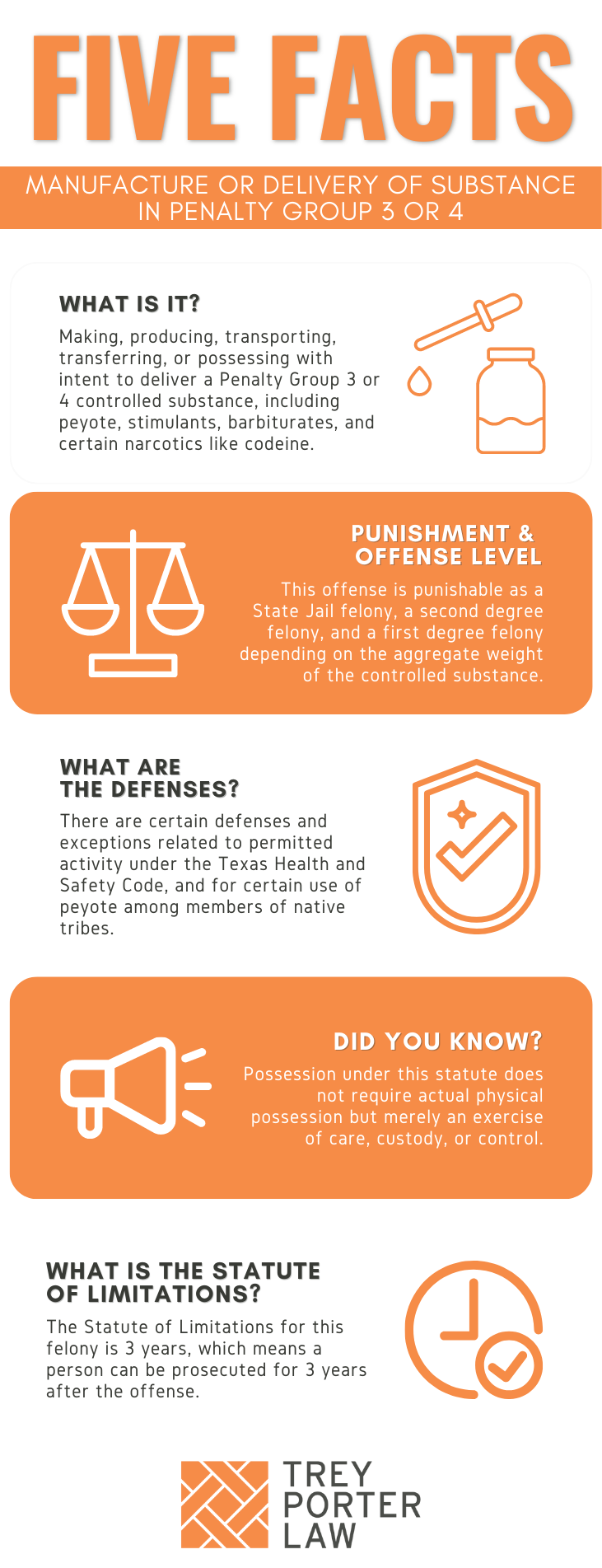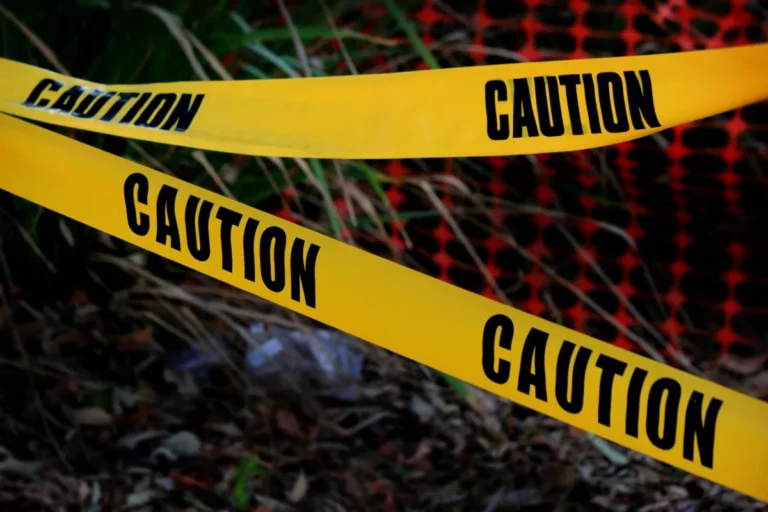WHAT IS MANUFACTURE OR DELIVERY OF SUBSTANCE IN PENALTY GROUP 3 OR 4 IN TEXAS?
The Texas law against manufacture or delivery of substance in Penalty Group 3 or 4 prohibits making, producing, transporting, transferring, or otherwise possessing with the intent to deliver a controlled substance listed in Penalty Group 3 and Penalty Group 4.
- What is a controlled substance? Texas Health and Safety Code Section 481.002 defines a “controlled substance” as a substance, including a drug, listed in Schedules I through V or Penalty Group 1, 1-A, 1-B, 2, 2-A, 3, or 4. The term includes the aggregate weight of any mixture, solution, or other substance containing a controlled substance, but does not include “hemp” as defined by Texas Agriculture Code Section 121.001, or the tetrahydrocannabinols in hemp.
- What is the difference between Schedules I, II, III, IV, and V and the penalty groups of controlled substances? Controlled substances are divided into five “schedules” based on potential for abuse or addiction, which dictate the rules medical professionals must follow in prescribing medications listed in each schedule. Schedule I, for example, are the most addictive substances, and may generally not be prescribed. Substances in Schedule I are also typically in Penalty Group 1, and are considered illegal under most circumstances.Controlled substances are divided into “penalty groups” for determining criminal classification and penalties.
- What controlled substances are in Penalty Group 3 in Texas? Texas Health and Safety Code Section 481.104 lists the following controlled substances in Penalty Group 3:
- a material, compound, mixture, or preparation that contains any quantity of the following substances having a potential for abuse associated with a stimulant effect on the central nervous system:
- Methylphenidate and its salts; and
- Phenmetrazine and its salts;
- a material, compound, mixture, or preparation that contains any quantity of the following substances having a potential for abuse associated with a depressant effect on the central nervous system:
- a substance that contains any quantity of a derivative of barbituric acid, or any salt of a derivative of barbituric acid not otherwise described by this subsection;
- a compound, mixture, or preparation containing amobarbital, secobarbital, pentobarbital, or any salt of any of these, and one or more active medicinal ingredients that are not listed in any penalty group;
- a suppository dosage form containing amobarbital, secobarbital, pentobarbital, or any salt of any of these drugs, and approved by the United States Food and Drug Administration for marketing only as a suppository;
- Alprazolam;
- Amobarbital;
- Bromazepam;
- Camazepam;
- Carisoprodol;
- Chlordiazepoxide;
- Chlorhexadol;
- Clobazam;
- Clonazepam;
- Clorazepate;
- Clotiazepam;
- Cloxazolam;
- Delorazepam;
- Diazepam;
- Estazolam;
- Ethyl loflazepate;
- Etizolam;
- Fludiazepam;
- Flurazepam;
- Glutethimide;
- Halazepam;
- Haloxzolam;
- Ketazolam;
- Loprazolam;
- Lorazepam;
- Lormetazepam;
- Lysergic acid, including its salts, isomers, and salts of isomers;
- Lysergic acid amide, including its salts, isomers, and salts of isomers;
- Mebutamate;
- Medazepam;
- Methyprylon;
- Midazolam;
- Nimetazepam;
- Nitrazepam;
- Nordiazepam;
- Oxazepam;
- Oxazolam;
- Pentazocine, its salts, derivatives, or compounds or mixtures thereof;
- Pentobarbital;
- Pinazepam;
- Prazepam;
- Quazepam;
- Secobarbital;
- Sulfondiethylmethane;
- Sulfonethylmethane;
- Sulfonmethane;
- Temazepam;
- Tetrazepam;
- Tiletamine and zolazepam in combination, and its salts. (some trade or other names for a tiletamine-zolazepam combination product: Telazol, for tiletamine: 2-(ethylamino)-2-(2-thienyl)-cyclohexanone, and for zolazepam: 4-(2-fluorophenyl)-6, 8-dihydro-1,3,8,-trimethylpyrazolo-[3,4-e](1,4)-d diazepin-7(1H)-one, flupyrazapon);
- Tramadol;
- Triazolam;
- Zaleplon;
- Zolpidem; and
- Zopiclone;
- Nalorphine;
- a material, compound, mixture, or preparation containing limited quantities of the following narcotic drugs, or any of their salts:
- not more than 1.8 grams of codeine, or any of its salts, per 100 milliliters or not more than 90 milligrams per dosage unit, with an equal or greater quantity of an isoquinoline alkaloid of opium;
- not more than 1.8 grams of codeine, or any of its salts, per 100 milliliters or not more than 90 milligrams per dosage unit, with one or more active, nonnarcotic ingredients in recognized therapeutic amounts;
- not more than 300 milligrams of dihydrocodeinone (hydrocodone), or any of its salts, per 100 milliliters or not more than 15 milligrams per dosage unit, with a fourfold or greater quantity of an isoquinoline alkaloid of opium;
- not more than 300 milligrams of dihydrocodeinone (hydrocodone), or any of its salts, per 100 milliliters or not more than 15 milligrams per dosage unit, with one or more active, nonnarcotic ingredients in recognized therapeutic amounts;
- not more than 1.8 grams of dihydrocodeine, or any of its salts, per 100 milliliters or not more than 90 milligrams per dosage unit, with one or more active, nonnarcotic ingredients in recognized therapeutic amounts;
- not more than 300 milligrams of ethylmorphine, or any of its salts, per 100 milliliters or not more than 15 milligrams per dosage unit, with one or more active, nonnarcotic ingredients in recognized therapeutic amounts;
- not more than 500 milligrams of opium per 100 milliliters or per 100 grams, or not more than 25 milligrams per dosage unit, with one or more active, nonnarcotic ingredients in recognized therapeutic amounts;
- not more than 50 milligrams of morphine, or any of its salts, per 100 milliliters or per 100 grams with one or more active, nonnarcotic ingredients in recognized therapeutic amounts; and
- not more than 1 milligram of difenoxin and not less than 25 micrograms of atropine sulfate per dosage unit;
- a material, compound, mixture, or preparation that contains any quantity of the following substances:
- Barbital;
- Chloral betaine;
- Chloral hydrate;
- Ethchlorvynol;
- Ethinamate;
- Meprobamate;
- Methohexital;
- Methylphenobarbital (Mephobarbital);
- Paraldehyde;
- Petrichloral; and
- Phenobarbital;
- Peyote, unless unharvested and growing in its natural state, meaning all parts of the plant classified botanically as Lophophora, whether growing or not, the seeds of the plant, an extract from a part of the plant, and every compound, manufacture, salt, derivative, mixture, or preparation of the plant, its seeds, or extracts;
- unless listed in another penalty group, a material, compound, mixture, or preparation that contains any quantity of the following substances having a stimulant effect on the central nervous system, including the substance’s salts, optical, position, or geometric isomers, and salts of the substance’s isomers, if the existence of the salts, isomers, and salts of isomers is possible within the specific chemical designation:
- Benzphetamine;
- Cathine [(+)-norpseudoephedrine];
- Chlorphentermine;
- Clortermine;
- Diethylpropion;
- Fencamfamin;
- Fenfluramine;
- Fenproporex;
- Mazindol;
- Mefenorex;
- Modafinil;
- Pemoline (including organometallic complexes and their chelates);
- Phendimetrazine;
- Phentermine;
- Pipradrol;
- Sibutramine; and
- SPA [(-)-1-dimethylamino-1,2-diphenylethane];
- unless specifically excepted or unless listed in another penalty group, a material, compound, mixture, or preparation that contains any quantity of the following substance, including its salts:
- Dextropropoxyphene (Alpha-(+)-4-dimethylamino-1,2-diphenyl-3-methyl-2-propionoxybutane);
- an anabolic steroid, including any drug or hormonal substance, or any substance that is chemically or pharmacologically related to testosterone, other than an estrogen, progestin, dehydroepiandrosterone, or corticosteroid, and promotes muscle growth, including the following drugs and substances and any salt, ester, or ether of the following drugs and substances:
- Androstanediol;
- Androstanedione;
- Androstenediol;
- Androstenedione;
- Bolasterone;
- Boldenone;
- Calusterone;
- Clostebol;
- Dehydrochlormethyltestosterone;
- Delta-1-dihydrotestosterone;
- Dihydrotestosterone (4-dihydrotestosterone);
- Drostanolone;
- Ethylestrenol;
- Fluoxymesterone;
- Formebulone;
- Furazabol;
- 13beta-ethyl-17beta-hydroxygon-4-en-3-one;
- 4-hydroxytestosterone;
- 4-hydroxy-19-nortestosterone;
- Mestanolone;
- Mesterolone;
- Methandienone;
- Methandriol;
- Methenolone;
- 17alpha-methyl-3beta, 17 beta-dihydroxy-5alpha-androstane;
- 17alpha-methyl-3alpha, 17 beta-dihydroxy-5alpha-androstane;
- 17alpha-methyl-3beta, 17beta-dihydroxyandrost-4-ene;
- 17alpha-methyl-4-hydroxynandrolone;
- Methyldienolone;
- Methyltestosterone;
- Methyltrienolone;
- 17alpha-methyl-delta-1-dihydrotestosterone;
- Mibolerone;
- Nandrolone;
- Norandrostenediol;
- Norandrostenedione;
- Norbolethone;
- Norclostebol;
- Norethandrolone;
- Normethandrolone;
- Oxandrolone;
- Oxymesterone;
- Oxymetholone;
- Stanozolol;
- Stenbolone;
- Testolactone;
- Testosterone;
- Tetrahydrogestrinone; and
- Trenbolone; and
- Salvia divinorum, unless unharvested and growing in its natural state, meaning all parts of that plant, whether growing or not, the seeds of that plant, an extract from a part of that plant, and every compound, manufacture, salt, derivative, mixture, or preparation of that plant, its seeds, or extracts, including Salvinorin A.
- a material, compound, mixture, or preparation that contains any quantity of the following substances having a potential for abuse associated with a stimulant effect on the central nervous system:
Penalty Group 3 does not include a compound, mixture, or preparation containing a stimulant substance listed in Subsection (a)(1) if the compound, mixture, or preparation contains one or more active medicinal ingredients not having a stimulant effect on the central nervous system and if the admixtures are included in combinations, quantity, proportion, or concentration that vitiate the potential for abuse of the substances that have a stimulant effect on the central nervous system.
Penalty Group 3 does not include a compound, mixture, or preparation containing a depressant substance listed in Subsection (a)(2) or (a)(5) if the compound, mixture, or preparation contains one or more active medicinal ingredients not having a depressant effect on the central nervous system and if the admixtures are included in combinations, quantity, proportion, or concentration that vitiate the potential for abuse of the substances that have a depressant effect on the central nervous system.
- What controlled substances are in Penalty Group 4 in Texas? Texas Health and Safety Code Section 481.105 lists the following controlled substances in Penalty Group 4:
-
- a compound, mixture, or preparation containing limited quantities of any of the following narcotic drugs that includes one or more nonnarcotic active medicinal ingredients in sufficient proportion to confer on the compound, mixture, or preparation valuable medicinal qualities other than those possessed by the narcotic drug alone:
- not more than 200 milligrams of codeine per 100 milliliters or per 100 grams;
- not more than 100 milligrams of dihydrocodeine per 100 milliliters or per 100 grams;
- not more than 100 milligrams of ethylmorphine per 100 milliliters or per 100 grams;
- not more than 2.5 milligrams of diphenoxylate and not less than 25 micrograms of atropine sulfate per dosage unit;
- not more than 15 milligrams of opium per 29.5729 milliliters or per 28.35 grams; and
- not more than 0.5 milligram of difenoxin and not less than 25 micrograms of atropine sulfate per dosage unit;
- unless specifically excepted or unless listed in another penalty group, a material, compound, mixture, or preparation containing any quantity of the narcotic drug Buprenorphine or Butorphanol or a salt of either; and
- unless specifically exempted or excluded or unless listed in another penalty group, any material, compound, mixture, or preparation that contains any quantity of pyrovalerone, a substance having a stimulant effect on the central nervous system, including its salts, isomers, and salts of isomers.
- a compound, mixture, or preparation containing limited quantities of any of the following narcotic drugs that includes one or more nonnarcotic active medicinal ingredients in sufficient proportion to confer on the compound, mixture, or preparation valuable medicinal qualities other than those possessed by the narcotic drug alone:
WHAT IS THE MANUFACTURE OR DELIVERY OF SUBSTANCE IN PENALTY GROUP 3 OR 4 LAW IN TEXAS?
Tex. Health & Safety Code § 481.114. MANUFACTURE OR DELIVERY OF SUBSTANCE IN PENALTY GROUP 3 OR 4.
(a) Except as authorized by this chapter, a person commits an offense if the person knowingly manufactures, delivers, or possesses with intent to deliver a controlled substance listed in Penalty Group 3 or 4.
(b) An offense under Subsection (a) is a state jail felony if the amount of the controlled substance to which the offense applies is, by aggregate weight, including adulterants or dilutants, less than 28 grams.
(c) An offense under Subsection (a) is a felony of the second degree if the amount of the controlled substance to which the offense applies is, by aggregate weight, including adulterants or dilutants, 28 grams or more but less than 200 grams.
(d) An offense under Subsection (a) is a felony of the first degree, if the amount of the controlled substance to which the offense applies is, by aggregate weight, including adulterants or dilutants, 200 grams or more but less than 400 grams.
(e) An offense under Subsection (a) is punishable by imprisonment in the Texas Department of Criminal Justice for life or for a term of not more than 99 years or less than 10 years, and a fine not to exceed $100,000, if the amount of the controlled substance to which the offense applies is, by aggregate weight, including any adulterants or dilutants, 400 grams or more.
WHAT IS THE PENALTY CLASS FOR MANUFACTURE OR DELIVERY OF SUBSTANCE IN PENALTY GROUP 3 OR 4 IN TEXAS?
The penalty classification for manufacturing or delivering a controlled substance in Penalty Group 3 or 4 depends on the aggregate weight of the controlled substance manufactured, delivered, or in the person’s possession.
- State jail felony, punishable by 180 days to two years in a state jail facility, if:
- the aggregate weight was less than 28 grams;
- Second degree felony, punishable by two to 20 years in prison, if:
- the aggregate weight was 28 grams or more but less than 200 grams;
- First degree felony, punishable by five to 99 years or life in prison, if:
- the aggregate weight is 200 grams or more but less than 400 grams;
- First degree felony, punishable by ten to 99 years or life in prison, if:
- the aggregate weight is 400 grams or more.
Texas Health and Safety Code Section 481.134 increases the minimum prison sentence by five years and doubles the fine for manufacture or delivery of a controlled substance in Penalty Group 3 or 4 categorized as a felony, other than a state jail felony, if the offense was committed in a “drug-free zone.” The offense may be increased to the next highest category if committed within an institution of higher learning, within 300 feet of a public swimming pool or arcade, or within 1,000 feet of a residential treatment center.
- What is a drug-free zone in Texas? Texas Health and Safety Code Section 481.134 describes a drug-free zone as:
-
- in, on, or within 1,000 feet of premises of a school (including a day-care center), of premises owned, rented, or leased by an institution of higher learning, the premises of a public or private youth center, or a playground;
- on a school bus; or
- in, on, or within 1,000 feet of premises owned, rented, or leased by a general residential operation operating as a residential treatment center.
WHAT IS THE PUNISHMENT RANGE FOR MANUFACTURE OR DELIVERY OF SUBSTANCE IN PENALTY GROUP 3 OR 4 IN TEXAS?
The punishment range for manufacturing or delivering a controlled substance in Penalty Group 3 or 4 corresponds to the penalty classification, which depends on the aggregate weight of the controlled substance.
- 400 grams or more (first degree felony):
- ten to 99 years or life in prison, maximum $100,000 fine;
- 200 grams or more but less than 400 grams (first degree felony):
- five to 99 years or life in prison, maximum $10,000 fine;
- 28 grams or more but less than 200 grams (second degree felony):
- two to 20 years in prison, maximum $10,000 fine;
- Less than 28 grams (state jail felony):
- 180 days to two years in a state jail facility, maximum $10,000 fine.
WHAT ARE THE PENALTIES FOR MANUFACTURE OR DELIVERY OF SUBSTANCE IN PENALTY GROUP 2 OR 4 IN TEXAS?
A person charged with manufacturing or delivering less than a gram of a substance in Penalty Group 3 or 4 is eligible for probation after a conviction, or deferred adjudication without a conviction, for a period between two to five years, with the possibility of extending supervision for up to ten years.
A person charged with first-degree or second-degree felony manufacturing or delivering a controlled substance in Penalty Group 3 or 4 may be eligible for probation after a conviction, or deferred adjudication without a conviction, for a period not to exceed ten years. A person may only receive probation from a jury if the person has no prior felony convictions, and the jury assessed a prison sentence of ten years or less.
WHAT ARE THE DEFENSES TO MANUFACTURE OR DELIVERY OF SUBSTANCE IN PENALTY GROUP 3 OR 4 IN TEXAS?
Texas Health and Safety Code Section 481.111 contains an exemption for a person accused of manufacturing, delivering, or possessing with intent to deliver peyote who is a member of the Native American Church using the peyote for a bona fide religious ceremony or supplies the church with the peyote for that purpose.
Texas Health and Safety Code Section 481.123 provides a defense to a person charged with manufacturing, delivering, or possessing a controlled substance if the substance was approved as a new drug by the FDA, or was exempt by the FDA for investigational use.
Pentobarbital and anabolic steroids are also permitted, upon approval by the Federal Drug Enforcement Administration or other registry, for acquisition, cultivation, or delivery to use on animals under certain circumstances.
- What shows proof of intent to deal drugs in Texas? To convict a person of the higher offense of possession with intent to deliver a controlled substance, the State must show the accused possessed drugs for a purpose other than personal use. This may be shown by circumstantial evidence, the high volume of drugs, or any admissible statements the accused made during the investigation.For example, in Vega v. State, the defendant was sitting in the driver’s seat of a car with his wife when police approached. They saw marijuana in plain view, searched the car, and found a backpack on the floor when his feet were. Inside the backpack, police found ten baggies of methamphetamine. The backpack also had the defendant’s wallet and other possessions. He was convicted of possession with intent to deliver a controlled substance in PG1 (methamphetamine), and the appellate court affirmed.
- Is a lab test required in drug cases in Texas? Generally, yes. A person should not be convicted of possessing, manufacturing, or delivering a controlled substance in a specifically alleged penalty group without a lab report verifying the drug was the controlled substance alleged.In Ex parte Saucedo, the defendant was indicted for possession of methamphetamine, a controlled substance in Penalty Group 1. He pled before the lab results were sent to the prosecution, and was sentenced. The lab report revealed the defendant was actually in possession of methylethcathinone, a substance in Penalty Group 2. The Court of Criminal Appeals granted habeas relief, and cautioned all trial attorneys and defendants against pleading without all the evidence.
- What is drug possession in Texas? Texas Health and Safety Code Section 481.002 defines “possession” as actual care, custody, control, or management. Possession does not require proof a person is physically holding the controlled substance.In Rodriguez v. State, No. 04-21-00503-CR, the defendant’s girlfriend let her friend drive the defendant to the store. Police stopped the car while the defendant was in the passenger seat, and found 0.18 grams of methamphetamine in a chewing tobacco tin in the glove box. The officer noticed tobacco around the defendant’s mouth, so he was charged with and convicted of possession of less than a gram of a controlled substance in Penalty Group 1.The appellate court affirmed. The drugs were conveniently accessible to the defendant on his side of the car, they were in a tobacco tin, and the defendant chewed tobacco.
- What Penalty Group is codeine in Texas? Penalty Group 1 includes codeine “not listed in Penalty Group 3 or 4.” This means if the State alleges the accused possessed codeine, the State must prove the person possessed a substance containing more than 1.8 grams of codeine per 100 milliliters, or more than 300 milligrams of dihydrocodeine per 100 milliliters.In Miles v. State, the defendant was convicted of possession of over 200 grams of codeine in PG1 with intent to deliver. The lab results showed the codeine he possessed had a concentration of 158 milligrams of codeine per 100 milliliters, which is a substance in PG 3. The Court of Criminal Appeals reversed the defendant’s conviction, and acquitted him because of the failure to allege and prove the codeine was of a concentration listed in PG 1.
- What is a search incident to arrest in Texas? The Fourth Amendment to the U.S. Constitution permits police officers to conduct warrantless searches incident to lawful arrests. The justification for permitting such a warrantless search is: (1) the need for officers to seize weapons or other things which might be used to assault an officer or effect an escape; and (2) the need to prevent the loss or destruction of evidence. See State v. Granville, 423 S.W.3d 399, 410 (Tex. Crim. App. 2014).In State v. Sanchez, an officer approached the defendant’s jeep, which was parked in a grassy area next to a bar with the driver’s door open, the engine turned off, and the defendant was asleep in the driver’s seat. The officer woke the defendant up to check on him, and learned he had traffic warrants. Incident to arrest, the officer searched the defendant’s pockets, and he had cocaine. He was then arrested for possession of a controlled substance in PG 1, his car was searched incident to that arrest, and more cocaine was found. The appellate court upheld the car search as a valid search incident to his arrest for possession.In Botello v. State, police responded to an assault-in-progress. The officer spoke to the victim outside the home, who said the defendant was her estranged husband, had assaulted her, and was still inside. The defendant refused to come out, but the victim consented to a search of the home, so police forcefully went inside. Officers immediately arrested the defendant for assault, searched his pockets, and found over 24 grams of heroin. He was convicted of possession of a controlled substance in PG 1, and the appellate court affirmed.
WHAT IS THE STATUTE OF LIMITATIONS FOR MANUFACTURE OR DELIVERY OF SUBSTANCE IN PENALTY GROUP 3 OR 4 IN TEXAS?
The limitation period for manufacturing or delivering a substance in Penalty Group 3 or 4 is three years.
MANUFACTURE OR DELIVERY OF SUBSTANCE IN PENALTY GROUP 3 OR 4 IN TEXAS
Texas punishes manufacturing, transporting, delivering, or otherwise possessing with the intent to deliver a controlled substance in Penalty Group 3 or 4 in any amount as a felony.
TEXAS MANUFACTURE OR DELIVERY OF SUBSTANCE IN PENALTY GROUP 3 OR 4 COURT CASES
The case law regarding manufacture or delivery of substance in Penalty Group 3 or 4 in Texas illustrates the types of proof that will support a conviction.
- In Megwa v. State, the defendant was running a “pill mill,” or a pharmacy that fills fraudulent prescriptions. Police sent in an informant to do a controlled buy of hydrocodone without a prescription. The defendant sold the informant 120 pills of hydrocodone, and 60 pills of alprazolam, both controlled substances in Penalty Group 3. The defendant was convicted of delivery of 28 to 200 grams of a controlled substance in Penalty Group 3, and the appellate court affirmed.
- In Atkinson v. State, the defendant was stopped for a traffic violation, and the trooper smelled marijuana. He searched the defendant’s car, and found an ounce and a half of marijuana, 48.6 grams of Clonazepam, 10.1 grams of Diazepam, 45 grams of steroids, 28.9 grams of Carisoprodol, 28 grams of Trazodone, 28 grams of Alprazolam. The trooper also seized the defendant’s phone, and found texts showing the defendant was dealing.
The crime lab for the Texas Department of Public Safety conducted a chemical analysis of the pills. The defendant was convicted of possession of Clonazepam, a controlled substance in PG3, with intent to deliver an amount between 28 grams and 200 grams, and the appellate court affirmed.













